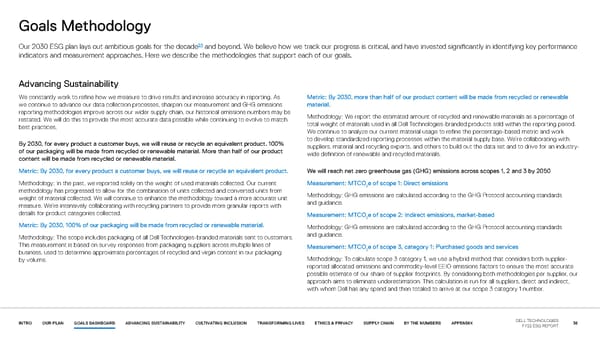Goals Methodology 20 Our 2030 ESG plan lays out ambitious goals for the decade and beyond. We believe how we track our progress is critical, and have invested significantly in identifying key performance indicators and measurement approaches. Here we describe the methodologies that support each of our goals. Advancing Sustainability We constantly work to refine how we measure to drive results and increase accuracy in reporting. As Metric: By 2030, more than half of our product content will be made from recycled or renewable we continue to advance our data collection processes, sharpen our measurement and GHG emissions material. reporting methodologies improve across our wider supply chain, our historical emissions numbers may be Methodology: We report the estimated amount of recycled and renewable materials as a percentage of restated. We will do this to provide the most accurate data possible while continuing to evolve to match total weight of materials used in all Dell Technologies-branded products sold within the reporting period. best practices. We continue to analyze our current material usage to refine the percentage-based metric and work By 2030, for every product a customer buys, we will reuse or recycle an equivalent product. 100% to develop standardized reporting processes within the material supply base. We’re collaborating with of our packaging will be made from recycled or renewable material. More than half of our product suppliers, material and recycling experts, and others to build out the data set and to drive for an industry- content will be made from recycled or renewable material. wide definition of renewable and recycled materials. Metric: By 2030, for every product a customer buys, we will reuse or recycle an equivalent product. We will reach net zero greenhouse gas (GHG) emissions across scopes 1, 2 and 3 by 2050 Methodology: In the past, we reported solely on the weight of used materials collected. Our current Measurement: MTCO e of scope 1: Direct emissions 2 methodology has progressed to allow for the combination of units collected and converted units from Methodology: GHG emissions are calculated according to the GHG Protocol accounting standards weight of material collected. We will continue to enhance the methodology toward a more accurate unit and guidance. measure. We’re intensively collaborating with recycling partners to provide more granular reports with details for product categories collected. Measurement: MTCO e of scope 2: Indirect emissions, market-based 2 Metric: By 2030, 100% of our packaging will be made from recycled or renewable material. Methodology: GHG emissions are calculated according to the GHG Protocol accounting standards Methodology: The scope includes packaging of all Dell Technologies-branded materials sent to customers. and guidance. This measurement is based on survey responses from packaging suppliers across multiple lines of Measurement: MTCO e of scope 3, category 1: Purchased goods and services business, used to determine approximate percentages of recycled and virgin content in our packaging 2 by volume. Methodology: To calculate scope 3 category 1, we use a hybrid method that considers both supplier- reported allocated emissions and commodity-level EEIO emissions factors to ensure the most accurate possible estimate of our share of supplier footprints. By considering both methodologies per supplier, our approach aims to eliminate underestimation. This calculation is run for all suppliers, direct and indirect, with whom Dell has any spend and then totaled to arrive at our scope 3 category 1 number. INTRO OUR PLAN GOALS DASHBOARD ADVANCING SUSTAINABILITY CULTIVATING INCLUSION TRANSFORMING LIVES ETHICS & PRIVACY SUPPLY CHAIN BY THE NUMBERS APPENDIX DELL TECHNOLOGIES 36 FY22 ESG REPORT
 Our purpose in action | Dell Page 35 Page 37
Our purpose in action | Dell Page 35 Page 37